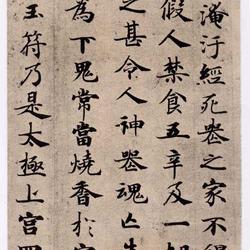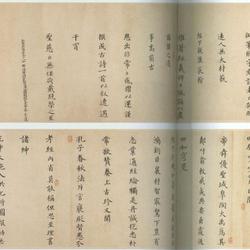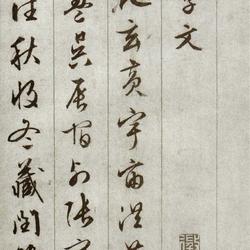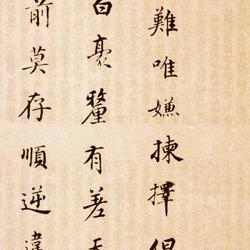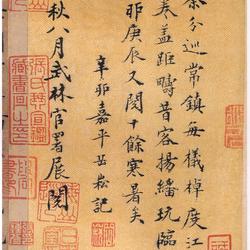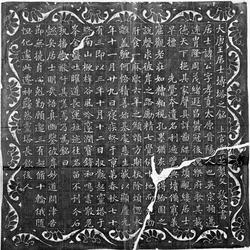On the third day of March in the ninth year of Yonghe reign of Emperor Mu of the Jin Dynasty (353), Wang Xizhi and forty-one other celebrities, including Sun Tong, Sun Chuo, Xie An and Zhi Dun, were practicing rice at the Orchid Pavilion in Kuaiji. During this period, he wrote thirty-seven poems, which were compiled into the "Orchid Pavilion Collection", for which Wang Xizhi wrote a preface. This is the "Preface to the Lanting Collection", "the best running script in the world", also known as "Lanting Preface" and "Lanting Collection".
The most outstanding works of art often contain extremely rich artistic beauty in a very small space. "Lanting Preface" is a miniature palace of calligraphy that stands tall in size. Emperor Taizong of the Tang Dynasty praised its "point-and-draft work and wonderful cutting." Huang Tingjian insisted: "The preface to Lanting is Wang Youjun's favorite calligraphy in his life. I have read it repeatedly and found that there is not a single word or stroke, which is unsatisfactory." Details. If you slightly dissect the horizontal strokes, you can find the exposed front horizontal, the front horizontal, the lowered head horizontal, the downward horizontal cross, the upward horizontal horizontal stroke, the parallel horizontal stroke, etc. You can adapt to your needs. The vertical paintings are either hanging needles, making jade tendons, falling dew, diagonally vertical, arcing vertically, hooks, curved heads, double branches protruding, or juxtaposed, each of which is wonderful. The points include oblique point, front point, curved point, flat point, long point, hook point, left and right point, up and down point, two water points, three water points, three horizontal points, right point, etc. There are oblique strokes, straight strokes, short strokes, flat strokes, long curved strokes, arc strokes, back-front strokes, hooked strokes, curved strokes, parallel strokes, etc. The pick may be short or long, and the fold may include horizontal fold, vertical fold, or diagonal fold. Among them, there are diagonal bows, flat bows, back-front bows, hooked bows, long-point bows, falcon-tailed bows, etc. The hooks include vertical hooks, vertical curved hooks, oblique hooks, horizontal hooks, right curved hooks, circular curved hooks, horizontal folding hooks, left flat hooks, and return hooks. No matter horizontally, vertically, dotted, left, hooked, folded or pressed, it can be said that it is the most wonderful way to use the pen to make sharp strokes. Each of the three hundred and twenty-four characters in "Lanting Preface" was created by Wang Xizhi to create an image of life, complete with muscles, bones, flesh and blood, and endowed with its own character, spirit, and demeanor: either sitting or lying down. , whether walking, walking, dancing, or singing, even if it is within a certain size, all the talents will arrive and all the appearances will appear. The richness of Wang Xizhi's wisdom is not only reflected in the heterogeneity of characters, but also more prominently in the heterogeneity of characters. There are more than twenty characters "Zhi" in the preface, none of them are similar, and each has its own unique charm. There are also important words such as "thing", "wei", "yi", "suo", "xin", "yang", "qi", "chang", "bu", "jin", "lan" and "huai". ", "Xing", "Hou", etc. are all unique and have their own wonderful compositions.
Dong Qichang wrote in "Essays on Painting a Zen Room": "Youjun's "Lanting Narrative" has the best composition in ancient and modern times. Its characters are all reflected in the tape, whether small or large, and they all follow the rules, so it is a god. It's a masterpiece." Later generations cherished the beauty of its cloth. Although the copyists could not help but incorporate their own style of writing, no one changed the composition of the cloth even a little. Just as Xie Jin said in "Chun Yu Miscellanies": "Youjun's poem "Lanting" is both beautiful in calligraphy and especially good in layout. The so-called gain is too long, and the loss is too short." "Lanting Preface" The composition is like a natural beauty, dancing gracefully, and the beauty of its dancing posture is unparalleled.
The Orchid Pavilion cultivated evil spirits, which enabled Wang Xizhi to realize the beauty of the landscape, the mystery of the universe and the true meaning of life. In a state of forgetfulness of things and myself, he wrote the eternal masterpiece "Preface to the Orchid Pavilion". It is precisely because of his deep feelings that he can His emotions are precise and natural, and because of his precise brushwork, he can make the bottom of his pen resemble flowing clouds and flowing water, with both form and spirit. And because he has all the beauties, he can finally reach the climax of this manuscript's writing. The state of harmony. In the face of this perfect work, although later generations of famous artists tried their best to imitate it, they failed to achieve it. Zhang Boyun of the Southern Tang Dynasty said: "Those who are good at Dharma calligraphy will each gain a part of the right army. If Yu Shinan gained his beauty but lost his handsomeness, Ouyang Xun gained his strength but lost his gentleness, Chu Suiliang gained his intention but lost his change, Xue Ji gained its purity but lost its embarrassment." Wang Xizhi himself only wrote this masterpiece. Later, he wrote the "Lanting Preface" again, but it could not match the wonder of the original work. Shen Yinmo said, "At that time, Yishao Bentian "Complete", praising the excellence of "Lanting Preface" has its irreproducible opportunities, and is naturally beyond the reach of others.
Jiang Kui in the Song Dynasty loved "Lanting Preface" very much. It is said that he had a total of four copies of "Lanting Preface", with inscriptions by Huang Tingjian, Wang Jinzhi, Ge Cyan and Shan Bingwen. He studied it every day and often wrote down what he had learned. There is a postscript that says: "I have been studying "Lanting" for more than 10 years, but I have no idea. I watched it under the lamp this evening, and I have some enlightenment." It took more than 20 years to get started, which shows the difficulty of interpretation: more than 1,600 years Countless calligraphers have worked tirelessly to interpret it, and why don't they want to delve deeper into Xizhi's secrets, but in the end they can only get a piece of it. Therefore, "Lanting Preface" can be said to be a labyrinth created by outstanding calligraphy wisdom.
"Lanting Preface" was collected by the people for 270 years after Wang Xi's death. Later, Emperor Taizong of the Tang Dynasty managed to earn money from the people and enter the imperial palace, and was later buried in Zhaoling. There are many types of handed down editions, some are wood and stone engravings, some are copies, some are copies. Famous works such as "Dingwu Orchid Pavilion" are said to be copied by Ouyang Xun. It was named after it was discovered in Dingwu, Hebei during the Northern Song Dynasty. "Lanting Preface to the Luoyang Palace Edition" is said to be Chu Suiliang's nineteenth copy. This edition was given to Gao Shanglian by Emperor Taizong of the Tang Dynasty. Chu Suiliang also passed down the "Shenlong Half-Sealed Edition of Lanting Preface" and "Zhang Jinjie Nu's Edition of Lanting Preface", because the former has the "Shenlong" half seal, and the latter has the words "Zhang Jinjie Nu Shangjin". There is also a copy of Feng Chengsu from Zhihong Wenguan, the enshrined calligrapher of Emperor Taizong of the Tang Dynasty, called "Shenlongbenlanting". This copy has the most vivid ink color and is regarded as a treasure. In addition, there are "Xue Ji edition", "Zi Pan Guifei edition", "Ying Shang edition", "Luo Shui edition", etc.
Although the original copy of "Lanting" was buried in Zhaoling, its incarnations have been copied and engraved and spread, and there are no less than hundreds of various books. During the Qianlong period of the Qing Dynasty, Zhao Wei first doubted the authenticity of "Lanting" and said: "From the Southern and Northern Dynasties to the early Tang Dynasty, the extant inscriptions often had the legacy of the official script. After the Kaiyuan Dynasty, they became purely modern. Although Youjun changed the official script, it should not The ancient method is dead. If the current engravings are not copied by people from the Tang Dynasty, they will be copied incorrectly." During the Guangxu period of the Qing Dynasty, Li Wentian believed that the text of "Lanting" was forged and the book was forged by later generations. In 1965, a great debate arose about the authenticity of Lanting. One party, led by Guo Moruo, thought it was "fake", while the other party, who was a sophomore in high school, refuted it. In 1973, Cultural Relics Publishing House compiled "Lanting Theory" and collected eighteen related papers. Since then, many treatises have been published discussing the authenticity of "Lanting". Although the famous scholar Qian Zhongshu did not participate in the debate at that time, his thoughts and insights on the debate on "Lanting" were reflected in Guan Zuibian published in 1979. Qian Zhongshu's letter published in the People's Daily on May 24, 1988 pointed out more clearly: "Ruan Wenda's theory of 'Southern Post and Northern Stele' has not been found in the Southern Dynasties. The square structure of the stele is the same as that of the North Stele. "When Guo Moruo saw the Nanbei, he said that the "Lanting Preface" written by Shi Chuan Youjun was not in the Jin and Song calligraphy styles, and must be forged by later generations. It was seen in the corner and looked round, and Wenda fell to one side." That is to say, he thought that each had his own bias. This can inspire us to further explore this academic topic.
In short, we believe that the examination of the authenticity of "Lanting" should not only focus on the cultural background of the time, but also focus on the innovative motivations and achievements that made Wang Xi become a generation of "sage of calligraphy". Of course, depending on the excavation of more cultural relics, scientific conclusions may one day be reached.
Author: Yao Ganming (text)

